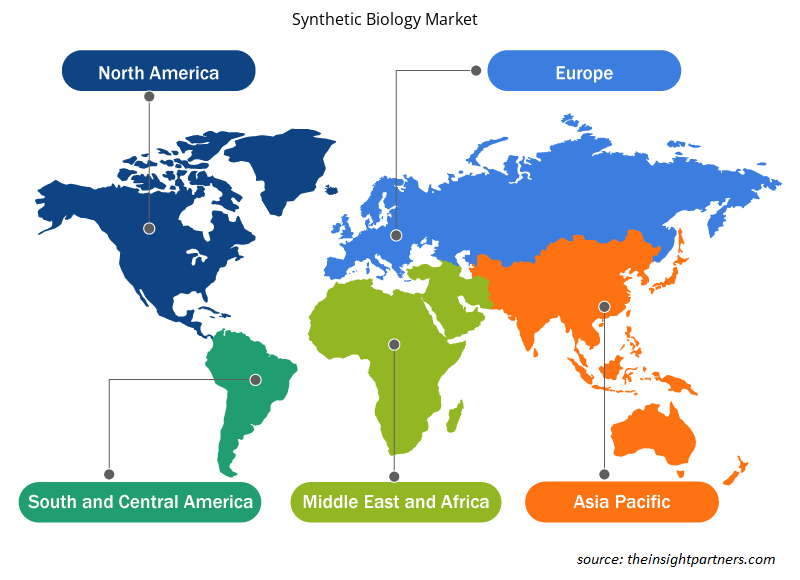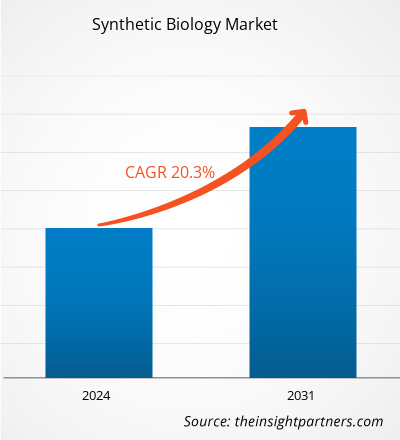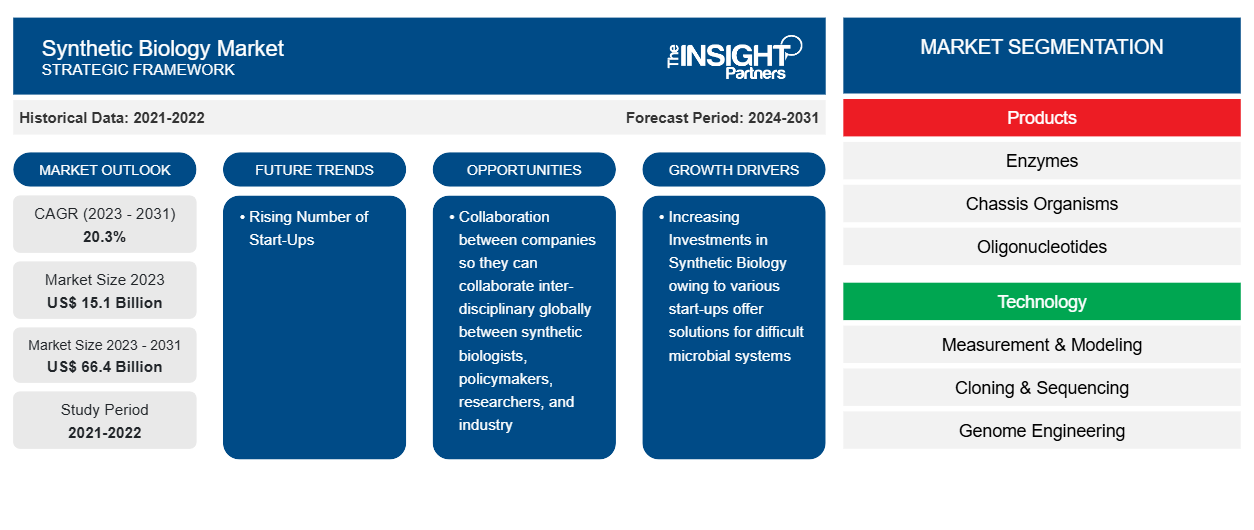Si prevede che la dimensione del mercato della biologia sintetica raggiungerà i 66,4 miliardi di dollari entro il 2031, rispetto ai 15,1 miliardi di dollari del 2023. Si prevede che il mercato registrerà un CAGR del 20,3% nel periodo 2023-2031. È probabile che la biologia sintetica avanzata rimanga una tendenza chiave nel mercato.
Analisi di mercato della biologia sintetica
I fattori chiave che guidano la crescita del mercato sono gli investimenti crescenti nella biologia sintetica e il crescente numero di start-up. La biologia sintetica offre alle aziende un'ampia gamma di opportunità per collaborare interdisciplinari a livello globale tra biologi sintetici, decisori politici, ricercatori e industria. Ad esempio, nell'agosto 2021, Codex DNA ha annunciato una collaborazione di biologia sintetica con il Dipartimento dell'agricoltura degli Stati Uniti per identificare misure terapeutiche scalabili contro la malattia del citrus greening.
Panoramica del mercato della biologia sintetica
La biologia sintetica è un concetto emergente con numerose applicazioni nei settori chimico, agricolo, farmaceutico ed energetico. Diverse start-up offrono soluzioni per sistemi microbici complessi. Ad esempio, la startup statunitense Asimov offre una piattaforma di progettazione genetica per la biologia sintetica dei mammiferi. Integrano biologia sintetica, misurazione multi-omica, modellazione computazionale e apprendimento automatico in un'unica piattaforma per promuovere applicazioni terapeutiche. Inoltre, Benchling fornisce strumenti CAD, GenScript offre sintesi genica, Ginkgo Bioworks assiste nell'ingegneria degli organismi, Transcriptis (un'azienda di bioinformatica) offre soluzioni che facilitano i laboratori cloud/automazione e Glowee offre prodotti di consumo.
Personalizza questo report in base alle tue esigenze
Riceverai la personalizzazione gratuita di qualsiasi report, comprese parti di questo report, o analisi a livello nazionale, pacchetto dati Excel, oltre a usufruire di grandi offerte e sconti per start-up e università
-
Scopri le principali tendenze di mercato in questo rapporto.Questo campione GRATUITO includerà analisi di dati che spaziano dalle tendenze di mercato alle stime e alle previsioni.
Driver e opportunità del mercato della biologia sintetica
Numero crescente di start-up
Gli imprenditori della biotecnologia possono raccogliere rapidamente fondi e procurarsi attrezzature e spazi dai governi dei loro paesi. Ad esempio, il governo indiano ha finanziato IITM Bioincubator, una divisione dell'Indian Institute of Technology Madras, per istituire una struttura infrastrutturale di bioinformatica e un centro di ricerca all'avanguardia sulla biologia del cancro. Le organizzazioni includono il Department of Science and Technology (DST), il Department of Biotechnology (DBT) e il Council of Scientific and Industrial Research (CSIR) che hanno contribuito al finanziamento. In Cina, Chinaccelerator è un finanziatore che fornisce programmi di tutoraggio per aiutare le start-up. È anche associato a SOSV Investments LLC, che aiuta nella creazione di start-up fornendo fondi tramite programmi come RebelBio e Indie Bio. La facile disponibilità di fondi per le idee motiva gli imprenditori di tutto il mondo a creare attività di biologia sintetica.
Collaborazione tra aziende
La biologia sintetica è il ramo della biotecnologia che offrirebbe opportunità per quasi ogni aspetto del settore sanitario, tra cui la somministrazione di farmaci, la terapia proteica, i biocarburanti e lo sviluppo di prodotti alimentari e agricoli. Offre opportunità agli imprenditori della biotecnologia di accelerare la scoperta, ridurre i fallimenti clinici ed essere più efficienti in termini di costi. La biologia sintetica offre alle aziende un'ampia gamma di opportunità per collaborare interdisciplinari a livello globale tra biologi sintetici, decisori politici, ricercatori e industria. Ad esempio, nell'agosto 2021, Riffyn Inc. e il Centre dell'Imperial College hanno collaborato per Synthetic Biology (IC-CSynB) e i set London Biofoundry di SynbiCITE per la ricerca e l'istruzione sulla biologia sintetica nella riproducibilità scientifica. Questi sono i fattori principali che fanno crescere le aziende nel mercato della biologia sintetica e che probabilmente avranno un impatto sulla crescita del mercato nel periodo di previsione.
Analisi della segmentazione del rapporto di mercato sulla biologia sintetica
I segmenti chiave che hanno contribuito alla derivazione dell'analisi di mercato della biologia sintetica sono prodotto, tecnologia e applicazione.
- In base al prodotto, il mercato della biologia sintetica è segmentato in enzimi, organismi chassis, oligonucleotidi e acidi xenonucleici. Il segmento degli oligonucleotidi ha detenuto una quota di mercato maggiore nel 2023.
- In base alla tecnologia, il mercato è segmentato in misurazione e modellazione, clonazione e sequenziamento, ingegneria del genoma, sintesi genetica, nanotecnologia e altri. Il segmento della sintesi genetica ha detenuto la quota maggiore del mercato nel 2023.
- Per applicazione, il mercato è segmentato in applicazioni mediche, applicazioni industriali, cibo e agricoltura, applicazioni ambientali e altre. Il segmento delle applicazioni mediche ha detenuto la quota maggiore del mercato nel 2023.
Analisi della quota di mercato della biologia sintetica per area geografica
L'ambito geografico del rapporto sul mercato della biologia sintetica è suddiviso principalmente in cinque regioni: Nord America, Asia Pacifico, Europa, Medio Oriente e Africa, Sud e Centro America.
La biologia sintetica è uno strumento significativo per i progressi biologici, che offre potenziale per lo sviluppo di armi biologiche, possibili impatti negativi imprevisti sulla salute umana e qualsiasi potenziale impatto ambientale. I problemi di sicurezza possono essere evitati regolamentando l'uso della biotecnologia industriale attraverso una legislazione politica.
Le varie iniziative governative e i finanziamenti offerti sono un ottimo supporto per la crescita del mercato della biologia sintetica negli Stati Uniti. Ad esempio, secondo un rapporto del National Center for Biotechnology Information (NCBI), il governo degli Stati Uniti offre circa 220 milioni di dollari all'anno per la ricerca e lo sviluppo della biologia sintetica. Questo fondo include investimenti del Department of Energy, della National Science Foundation (NSF), del Department of Defense (DoD) (incluso DARPA), dei National Institutes of Health (NIH) e del US Department of Agriculture (USDA).
Approfondimenti regionali sul mercato della biologia sintetica
Le tendenze regionali e i fattori che influenzano il mercato della biologia sintetica durante il periodo di previsione sono stati ampiamente spiegati dagli analisti di Insight Partners. Questa sezione discute anche i segmenti e la geografia del mercato della biologia sintetica in Nord America, Europa, Asia Pacifico, Medio Oriente e Africa e America meridionale e centrale.

- Ottieni i dati specifici regionali per il mercato della biologia sintetica
Ambito del rapporto di mercato sulla biologia sintetica
| Attributo del report | Dettagli |
|---|---|
| Dimensioni del mercato nel 2023 | 15,1 miliardi di dollari USA |
| Dimensioni del mercato entro il 2031 | 66,4 miliardi di dollari USA |
| CAGR globale (2023-2031) | 20,3% |
| Dati storici | 2021-2022 |
| Periodo di previsione | 2024-2031 |
| Segmenti coperti |
Per prodotti
|
| Regioni e Paesi coperti |
America del Nord
|
| Leader di mercato e profili aziendali chiave |
|
Densità degli attori del mercato: comprendere il suo impatto sulle dinamiche aziendali
Il mercato della biologia sintetica sta crescendo rapidamente, spinto dalla crescente domanda degli utenti finali dovuta a fattori quali l'evoluzione delle preferenze dei consumatori, i progressi tecnologici e una maggiore consapevolezza dei benefici del prodotto. Con l'aumento della domanda, le aziende stanno ampliando le loro offerte, innovando per soddisfare le esigenze dei consumatori e capitalizzando sulle tendenze emergenti, il che alimenta ulteriormente la crescita del mercato.
La densità degli operatori di mercato si riferisce alla distribuzione di aziende o società che operano in un particolare mercato o settore. Indica quanti concorrenti (operatori di mercato) sono presenti in un dato spazio di mercato in relazione alle sue dimensioni o al valore di mercato totale.
Le principali aziende che operano nel mercato della biologia sintetica sono:
- TERMOFISHER SCIENTIFIC INC.
- Agilent Technologies, Inc.
- Merck KGaA
- Biolab della Nuova Inghilterra
- Tecnologie DNA integrate
- Twist Bioscienza
Disclaimer : le aziende elencate sopra non sono classificate secondo un ordine particolare.

- Ottieni una panoramica dei principali attori del mercato della biologia sintetica
Notizie e sviluppi recenti del mercato della biologia sintetica
Il mercato della biologia sintetica viene valutato raccogliendo dati qualitativi e quantitativi post-ricerca primaria e secondaria, che includono importanti pubblicazioni aziendali, dati di associazioni e database. Di seguito sono elencati alcuni degli sviluppi nel mercato della biologia sintetica:
- bit.bio e Ginkgo Bioworks hanno annunciato bit.bio come partner inaugurale del Ginkgo Technology Network. Il Network, lanciato, è un ecosistema rivoluzionario di partner tecnologici all'avanguardia impegnati a collaborare con Ginkgo per fornire nuove capacità integrate per guidare il successo nei programmi di R&S dei clienti. (Fonte: bit.bio, sito Web aziendale, febbraio 2024)
- Sumitomo Chemical Co., Ltd e Ginkgo Bioworks hanno annunciato un nuovo programma per sviluppare prodotti chimici funzionali con la biologia sintetica e ampliare la partnership di bioproduzione esistente tra le aziende. (Fonte: Sumitomo Chemical Co., Ltd, sito Web aziendale, luglio 2023)
Copertura e risultati del rapporto sul mercato della biologia sintetica
Il rapporto "Dimensioni e previsioni del mercato della biologia sintetica (2021-2031)" fornisce un'analisi dettagliata del mercato che copre le seguenti aree:
- Dimensioni e previsioni del mercato della biologia sintetica a livello globale, regionale e nazionale per tutti i segmenti di mercato chiave coperti dall'ambito
- Tendenze del mercato della biologia sintetica e dinamiche di mercato come fattori trainanti, vincoli e opportunità chiave
- Analisi dettagliata delle cinque forze PEST/Porter e SWOT
- Analisi di mercato della biologia sintetica che copre le principali tendenze di mercato, il quadro globale e regionale, i principali attori, le normative e i recenti sviluppi del mercato.
- Analisi del panorama industriale e della concorrenza che copre la concentrazione del mercato, l'analisi della mappa di calore, i principali attori e gli sviluppi recenti per il mercato della biologia sintetica
- Profili aziendali dettagliati
- Analisi storica (2 anni), anno base, previsione (7 anni) con CAGR
- Analisi PEST e SWOT
- Valore/volume delle dimensioni del mercato - Globale, Regionale, Nazionale
- Industria e panorama competitivo
- Set di dati Excel
Report recenti
Rapporti correlati
Testimonianze
Motivo dell'acquisto
- Processo decisionale informato
- Comprensione delle dinamiche di mercato
- Analisi competitiva
- Analisi dei clienti
- Previsioni di mercato
- Mitigazione del rischio
- Pianificazione strategica
- Giustificazione degli investimenti
- Identificazione dei mercati emergenti
- Miglioramento delle strategie di marketing
- Aumento dell'efficienza operativa
- Allineamento alle tendenze normative























 Ottieni un campione gratuito per - Mercato della biologia sintetica
Ottieni un campione gratuito per - Mercato della biologia sintetica